The best studio headphone amplifiers are not the overly expensive audiophile amps with exposed tubes and a dash of pixie dust. Those are for personal use designed to look magical enough to fool consumers into spending far more than remotely necessary. As us professionals know, the way a piece of studio gear looks has nothing to do with the audio quality it can produce…
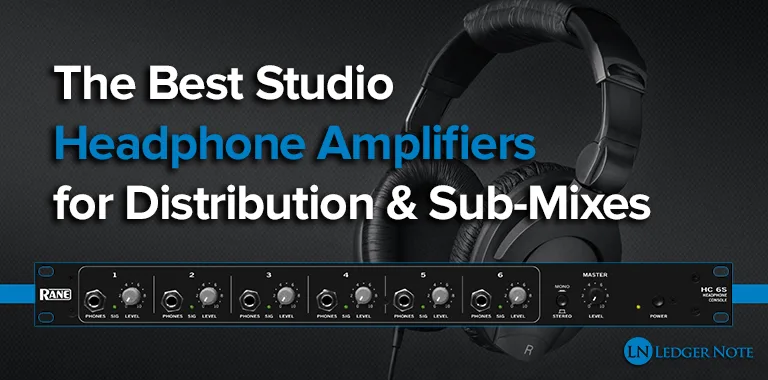
Besides, those portable and desktop headphone amps can’t provide the features a pro music studio needs in terms of routing and distributing signals, let alone allowing for monitoring sub-mixes. Today we look at the real-deal useful and best studio headphone amplifiers.
There are some despicable marketers out there building and selling single-channel headphone amps that cost more than a down payment on a house… zero exaggeration.
It’s tempting to get into how silly that is, especially since you can’t find much honest information about headphone amps online. But that would make this post be another addition to the nonsense.
Need more information in order to better understand your needs? We have got you covered! Visit our FAQs section.
INCLUDED IN THIS GUIDE:
| SCHIIT MAGNI 3 | Best Entry Level Amp | Buy on Amazon |
| JDS LABS OBJECTIVE2 + DAC | Best Budget Pick | Buy on Amazon |
| GRACE DESIGNS M920 | Best of the Best | Buy on Amazon |
| BENCHMARK DAC2 DX | Great Choice for Those Using Digital Inputs | Buy on Amazon |
| PRESONUS HP4 | Best Entry Level Multichannel | Buy on Amazon |
| RANE HC-6 | Best Intermediate Multichannel Choice | Buy on Amazon |
| PRESONUS HP60 | Best Bang for the Buck | Buy on Amazon |
| ART HEADAMP6 | Most Versatile Amp | Buy on Amazon |
The Best Studio Headphone Amplifiers
As a mixer or pleasure listener looking for the highest quality of a single channel, then the ones directly below are just for you. As a studio engineer in charge of tracking and recording, scroll down to the multi-channel options.
Some mixers pull double duty as well, especially when the mixing desk is in the live room. In this case I would want a single and a multi-channel to avoid having to get up to adjust the volume or route through extra monitor controllers.
Single-Channel Desktop Amps
These are for the music mixer or someone who really enjoys listening to music. You may be wondering if you need an amp for your headphones if you already a recording interface with headphone jacks on it.
It depends on how nice your interface is. As a hobbyist you’re probably okay. But if you’ve gone out of your way to buy special mixing headphones then you’d likely get use out of the quality gains you’d receive with a dedicated amp.
Just make sure you get something obviously much nicer so you aren’t buying a redundant piece of gear.
SCHIIT MAGNI 3
The Schiit Magni 3 is an improvement over the first and second widely praised models, welcoming the addition of a fully discrete gain stage. As someone looking for the best option at the lowest price point as an entry into the amp world, this bad boy is your friend. I wouldn’t recommend anything cheaper nor anything else in this range.
I love the compact, sleek chassis with the minimalist front design. The headphone input, as with all serious headphone amps, is 1/4 inch. The inputs on the back are stereo RCA jacks which are readily available at almost any shopping center or online.
There are now RCA outputs with inline preamps so you can even power your speakers off of it too. It has a delayed start-up and instant shutdown so you never hear clicks and pops when you fire it up. And they finally got rid of that custom jack for the power adapter, so you don’t even have to worry about that any more.
This is a no-frills option for anyone with a limited budget that doesn’t want to compromise on quality. You plug in your headphones and choose a volume and you’re rocking and rolling. There are cheaper portable systems and desktop solutions that suck for anyone who’s being serious and realistic. This is what you want at as a baseline.
Specs:
- Dimensions: 5″ x 3.5″ x 2.5″
- Item Weight: 2.4 pounds
Pros:
- Great value for the money
- Excellent quality and impressive build
Cons:
- Oversized power adapter in a wall wart design.
JDS LABS OBJECTIVE2 + DAC
I’m a huge fan of DIY studio gear. The maniacs doing the designs are just as good if not better than giant corporations and find ways to cut prices that others aren’t willing to do. You remember the Northwest Audio & Video Guy I linked to above?
He designed this JDS Labs Objective2 + DAC and open-sourced the whole thing. It’s got the quality of amps four times the cost and he put it out there for free… if you’re willing to hunt the parts and solder it together and not have a chassis.
Or you can do like most of us do and toss the guy a few bones for a pre-built version. A head’s up: it takes a typical AC adaptor but doesn’t come with one, so scoop one up while your at it so it arrives along with the amp! You can even toss a 9 volt battery in it and use it as a portable device if you’d like.
You may notice that the power adaptor and stereo inputs are on the front. This is for those who will drop it in a coat pocket or backpack so all of the knobs are facing up. The back has a mini-USB input (it comes with a mini-USB to USB cable) so you can bring the input from your computer straight into the custom Digital/Analog Converters. So this is already removing the 2nd weakest link after the amp too.
Your solid headphones, plus this amp and DAC equals mixing and listening heaven. This is your best cost-effective option for professionals before you jump into the higher-priced options with more functionality. The quality is in this one, it just has less buttons to tinker with!
Specs:
- Dimensions: 6.02 x 4.69 x 1.97
- Item Weight: 11 ounces
Pros:
- Excellent build quality
- Ability to swap op-amps
Cons:
- Only AC Powered
GRACE DESIGNS M920
Now we’re in the big leagues. At this point it’s not just about amps. You’re going to get a full-fledged monitoring system, and the Grace Designs m920 brings the power. First up is the various numbers of input types it can accommodate including S/PDIF, AES, TOSlink, USB, XLR, and RCA.
The digital inputs run through the built-in DAC offering sample rate options and clocking for jitter rejection. Your signal will then be pumped out of the two headphone jacks on the front or two more sets of studio monitor outputs on the back. To ensure safe levels of listening you can read the decibel monitor on the front, displaying 64 dB on the picture above.
In the headphone outputs you can enable a cross-feed option to bleed a bit of each channel into the other for more realistic and real-world monitoring. What else is cool is you can quickly compare your mix in two sets of reference monitors on the fly with the push of a button on this things remote control. That’s awesome. Oh, and you can drop to mono too, which is a classic mixing trick.
You’ll pay the price to play at this level of audio definition and work flow, but this is one of those “buying for life” scenarios. You’ll never need to upgrade after this. Same goes for the next choice below.
Specs:
- Dimensions: 1.70 x 8.50 x 8.25″
- Item Weight: 5 lb
Pros:
- Great build quality
- Great sound quality
Cons:
- Strange hum when muted,
BENCHMARK DAC2 DX
The Benchmark DAC2 DX is another full-on monitoring control system. You can expect all of the features mentioned in the choice above but with some differences in inputs and outputs. This beauty offers 5 digital inputs to use with the DAC. These include USB, two optical, and two coaxial (for televisions and consumer stereo systems). You have RCA inputs for analog as well if you don’t need the DAC at the time.
You’ve got your clock for jitter reduction, the ability to cross-feed, switch inputs and outputs for referencing, and even switch polarity if you’re encountering phase issues wherever you’re sitting. What I love about these high-end amps is you can do it all from the remote control too. You never even have to lean forward or extend an arm. It’s the little things!
Like the Grace m920 above, you’re buying for life here and it’s worth it if your budget can allow it. You’ll never need another.
Specs:
- Dimensions: 9.33 x 9.5 x 1.73
- Item Weight: 4 pounds
Pros:
- Clean, precise sound
- Impressive detail resolution
- Good features set
Cons:
- Sound could be more exciting
- Not at its best working as a preamp
Multi-Channel Rackmount Amps
You’ll notice all of these are rackmounted. That’s the standard format for gear of this type and size, as you likely know if you’re looking at this section. It’s so you can rack it in the recording room instead of the control room. This way the band can reach it to change the volumes and sub-mixes.
PRESONUS HP4
I include the PreSonus HP4 at the start of this section for two reasons: PreSonus doesn’t make shoddy gear and there needs to be one “lowest-I-would-go” recommendation. If you’re constrained by your budget and just have to have something to boost the headphones for a four piece band, this is it.
As always, if you can save a bit more and spring for something a bit nicer below with 6-channels you’ll be happier, but this piece gets the job done.
In this case, the game isn’t about improving the quality. You have a simple set-up. You can input one source on the back with TRS cables. You can output that to monitors that you can mute too. But at that point, it’s all about sending that signal faithfully enough to four headphones with independent volume controls. Beyond that, you can drop to mono while mixing in the monitors.
Don’t get me wrong. These aren’t amazing relative to others on this list but they are aeons beyond others not on the list and you get four amps that out-perform other single channel units that cost twice as much. PreSonus doesn’t play around.
They move a lot of units which allows them to extend price breaks deeper than other companies are willing to. This is what you want if you’re in a “Give me something now with at least four channels that’s decent, won’t break, and doesn’t cost too much” situation.
Look below for multi-channel options with six channels and more bells and whistles.
Specs:
- Dimensions: 5.5 x 1.75 x 5.5
- Item Weight: 3.2 pounds
Pros:
- Great build quality
- Does not distort at high volumes
Cons:
- Power supply cord does not fit well into the unit
RANE HC-6

Full disclaimer, I’ve never used the Rane HC-6 but it was short-listed when I was hunting for an amp. I’m still impressed by it’s willingness to trust the user. If you’re comfortable taking the top of the chassis off, you can install jumpers and squeeze some extra features out of this beast. It’s condoned by Rane and they provide directions.
I think my favorite part of this is that while there are 6 outputs on the front, each channel has an additional output on the back that can go to more headphones, bringing you up to 12 sets powered, or you can output to monitors too. If you run 12 sets of headphones, every two will share one volume control on the front, but still! It’s pretty sweet.
And for the best part, it has the More Me function mentioned above. It’s why there is a master input for the backing track and then individual inputs for each headphone. You can let each musician balance the volume of their own voice or instrument in the headphones. This is incredibly useful and a huge time saver.
Specs:
- Dimensions: 5 pounds
- Item Weight: 20 x 13.5 x 4.3
Pros:
- Awesome performance
- Excellent build quality
Cons:
- Lacks balanced inputs
PRESONUS HP60
This is the reason I didn’t get the Rane above. The PreSonus HP60 has all of the features of the Rane a bit cheaper and I’m comfortable with PreSonus. That’s no knock on the Rane. It may produce better quality audio, but for tracking and recording that wasn’t as important for me as just having a ton of channels I knew I could trust.
In addition to the More Me features that were a must (as describe above) so musicians could give me some peace from constantly tweaking their volumes for them, it also has a built in Talkback feature.
What this allows is for you to route a mic cable and a foot pedal from the control room into the live room and into the HP60. So if you need to speak to the band, they can talk to you in their mics and then you can hit the foot pedal and speak comfortably from where you’re at. They’ll hear you right in the headphones.
You can mute, drop to mono, switch between two input sources (to compare mixes), and even blend the two input sources. So you could route in a click track on top of the backing track or any number of clever set-ups. It’s all about what gets the best performance out of the band (and keeps them from driving you nuts)!
Pro Tip: You can also daisy chain two HP60’s or even one of the HP4’s mentioned above to expand to even more channels!
sc name=”ex-affiliate” asin=”B000V0EKXC”][/sc]
Specs:
- Dimensions: 19 x 1.75 x 5.5
- Item Weight: 7.4 pounds
Pros:
- Great price point and great build
Cons:
- Performance can be better
ART HEADAMP6

I have to mention the ART HeadAmp6. To avoid being long-winded, let me sum it up like this. The HeadAmp6 does everything the other nice multi-channel headphone amps above do, but it adds one more feature. So in addition to Talkback, More Me sub-mixing, jumping up to 12 headphone outputs and more, you can also EQ each channel separately.
Imagine a scenario where the bassist wants more bass volume because he can’t hear himself well yet (it’s unmixed!). More volume isn’t helping. She or he can waltz themselves right over to the amp and equalize their own input to add more bass or slurp out some treble. On top of all that, each channel has volume meters right on the front.
What I appreciate as well is the balance knobs. Not everyone wants the same level on the master volume and this allows you to remove or add more of it while still independently controlling your own mic or instrument volume.
And to top it all off, it’s relatively inexpensive. It’s not going to blow your mind by unveiling hidden qualities of your headphones, which isn’t the point. It’s a tank that can take a beating in the live recording room and can power a ton of cans faithfully so you can get your job done quicker with more comfort.
Specs:
- Dimensions: 1.75 x 19 x 7.5
- Item Weight: 7.55 pounds
Pros:
- Versatile and great sound quality
Cons:
- Lacks true response in the low end
FAQs
The plan here is to dispel why you don’t need to spend a fortune, what you really need, and then to offer some solid recommendations that actually do what you need to get some serious work done while recording and tracking music.
Headphone amplifiers have three legit functions:
- To power one really nice set of mixing headphones
- To distribute the signals to 4-to-8 sets of headphones for a band in the studio
- To offer the ability for those band members to tweak their own sub-mixes
That’s it. Talk of unicorns and fairies enhancing audio through the sorcery of analog tubes and all of this other nonsense should be ignored. No amp can do any better than the headphones you’re using.
There are no $20,000 headphones, which is why it’s incredible that there are amps that expensive and some people actually buy them. I’m not even kidding.
Let’s take a look at what you need to know to make an informed decision about what to buy before we look at a handful of the current best options.
By the way, if anyone tells you you need an amp like this one then they’re in on the scam somehow:
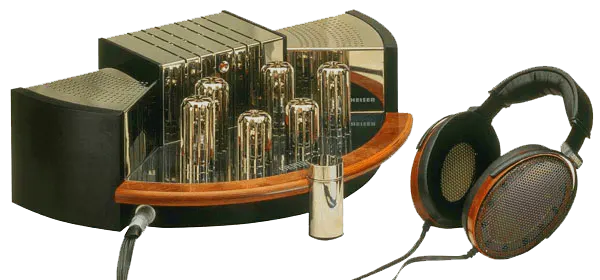
The Orpheus might sound like a great deal depending on how gullible you are. Otherwise, let’s move forward to learn about the legit amps of the professional audio industry, desktop single-channels and rackmounted multi-channels alike.
What is a Headphone Amp?
It helps to understand how headphones work to comprehend just what a headphone amp is and does. Earphones are literally just teeny tiny speakers. Headphones are a step up in size with circumaural (around the ear) headphones being quite larger than supra-aural (on your ear) ones.
Just like a home entertainment system, movie theater, and stadium concert speakers, the larger speakers get the more power they require to produce sound at an equal level and especially at insanely high volumes.
While size and volume isn’t the whole story, it does serve to illustrate the point. Headphone amplifiers are designed to supply enough voltage to power headphones that need it. There are more headphones, even in the professional studio world, that don’t need it than do.
But we still buy the multi-channel amps in order to route and distribute backing tracks and whatever else to a lot of headphones at once, because a single amp won’t be able to power eight pairs of cans at once.

What people tend to not realize is that every single speaker and headphone requires an amp. It’s just that we’ve dropped the specification for resistance low enough that small amps can now drive your typical set of earphones.
These amps are so small that they are being built inside of our computer sound cards, portable MP3 players, smart phones, etc. They’ve become invisible to us.
What this means is that a set of $10 earbuds might sound better at 80 dB plugged into an iPhone than a set of $300 dollar studio headphones at the same volume in the same iPhone.
It’s not about getting more volume. It’s about getting more quality at a given volume.
This leads us to the main question:
Why Do I Need The Best Studio Headphone Amplifier For My Headphones?
Let’s break down the three purposes mentioned above:
As a Music Mixer
This is the same for anyone listening in headphones for pleasure. When you purchase the best studio headphones you can find, the result becomes that the headphones are no longer the weakest link in your signal chain.
Nine times out of 10 it’s now the amplifier trying to drive these new sensitive woofers. Your iPhone just can’t spit out enough power. If it could it’d drain the battery really quickly.
Just as a point of illustration, this is why a lot of standalone and portable headphone amps now include USB Digital-to-Analog Converters, because your DAC will be the next weakest link in the chain. You won’t need to worry about that since your using a mixing board or top audio interface that has good DAC’s in them.
The problem arises from professional headphones still following the older standards of using circuitry with relatively high impedance. This means that the little amps of today need to drop a ton of voltage to power big boy headphones (they don’t do it well).
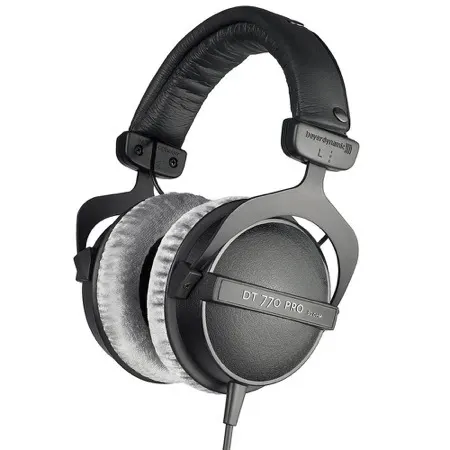
We’ll cover this in more detail below.
The way you know you aren’t getting enough power is if the headphones can’t get loud enough even at maximum volume and they start distorting at the peaks well before that. It’s a symptom of being under-powered. So to extract the top audio quality out of the amazing headphones you have you’ll have to get a bigger amp.
As a Studio Engineer
You bring bands into the studio and toss each of the six members a set of standard headphones. None of the headphones are amazing nor do they need a lot of power. But there’s six of them all sharing the juice meant for one. This is why recording studios buy multi-channel headphone amps.
Let me say this while we are at it. Think about it before buying a four-channel headphone amp. Grabbing six channels will accommodate a five-piece band.
There will come a time when you’re scrambling trying to split signals because you only bought four channels. Think ahead. If you need four then there’s a huge chance you’ll eventually need five or six.
The nicest feature in some of these multi-channel amps is the “More Me” option. Before, we’d have to route a ton of sub-mixes around to the amps and keep track of each one because the drummer is going to ask for more snare in his headphones.
The guitarist will want to hear more of the bass. Juggling all of this constantly sucks, but the More Me feature lets the band members tweak all of that themselves without affecting each other’s sub-mixes.
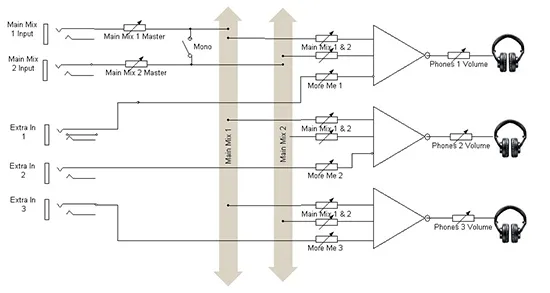
That’s fantastic as it offloads one of our jobs onto the band members who can get what they want without having to relay it through you. But the main job of these amps is related to…
Impedance, Current, & Voltage
This is mainly related to the topic of powering one high-quality pair of headphones but everyone should know about it even if you’re just looking for a multi-channel amp.
We said woofer size and volume weren’t the only reasons we need the best studio headphone amplifier. Insufficient power may impede your headphones ability, for example, to produce enough volume in the bass frequencies.
While they may be able to produce volume in the mid and high regions, they may begin distort as they can’t produce the fine resolution needed with such low power.
The issue is one of quality at every volume, not just high volumes.
This article by the Northwest Audio & Video Guy explores the electronics topic in full depth if you’re interested. I’m going to give you the “good enough” summary.
Resistance, and thus impedance, is measured in ohms (Ω). You can think of it in terms of a water hose. The higher the impedance, the smaller the opening of the water hose’s nozzle will be. That means to keep pumping out a certain volume of water (current) you’ll need to supply more water pressure (voltage).
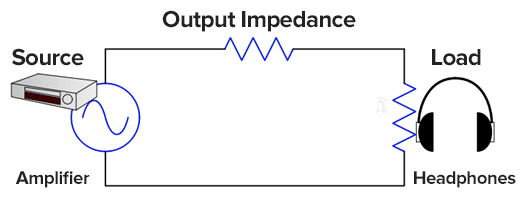
This is why new tiny amps can provide enough power, because most consumer headphones are designed at a range of 4-32 Ω. That’s very low and the current remains high without a lot of output power. Professional mixing headphones can have impedance ratings as high as 300 Ω and even 600 Ω.
That means you need a lot more voltage to push the electrons through the wire, a lot more than the measly amps of today can provide on these battery packs and still guarantee a certain charge lifetime.
To get a little technical without providing the mathematical conversions, check this out. A portable MP3 player might be able to provide 15 mW of power into earbuds with 15 Ω of impedance. That means you can crank up the volume to a good 110 dB no problem.
Try the same with studio headphones with 300 Ω impedance and you’ll only supply about 0.7 mW of power. Therein lies the problem that makes an amp the solution.
Can I Over Power My Headphones & Damage Them?
The short answer is no, not in the normal range of listening with headphones.
If you go above 100 dB and especially 110 dB for more than a song or two, you’re crazy or your hearing is already damaged. That’s really loud and safe for all headphones.
If you pushed the volume knob up to 11 by accident you might hurt your headphones just like you would any speaker that size. Most headphone amps aren’t going to let you get that loud. Just don’t plug your headphones into the amp for a football stadium.
The same goes for mismatching output impedance from the amp to the impedance of the headphones. The rule of thumb for best quality is the 10-to-1 ratio, where the headphones have around ten times the impedance of the output jack of the amp. You won’t damage anything but you will change the frequency response.
Now that the talky-talk is out of the way, we can look at some hardware!





